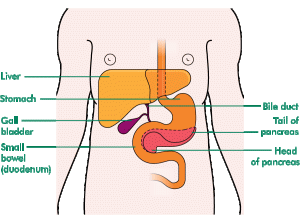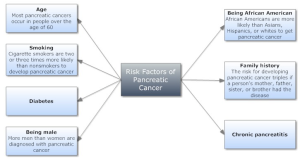Last week I was attending a lecture at the University when the word “pancreatic cancer” came out. Since then, I realized that I do not have too much knowledge about pancreatic cancer but I would like to know more about it and understand all the mechanisms behind this disease.
In this post I will try to explain you more about this lethal type of cancer, its treatments and its incidence amongst the public.
Pancreatic cancer is the fifth most lethal cancer in the UK with a survival rate of 4% after five years of being diagnosed. It is not a common type of cancer and its detection tends to be late, meaning that it is often too late for treatment.
Pancreas
The pancreas forms part of the digestive system. It is a gland located in the upper half of the abdomen.
It lies behind the stomach and just in front of the backbone and it is surrounded by the small bowel, the liver, the spleen and the gall bladder.
The pancreas has two main roles:
- Exocrine function: produces enzymes that help to digest food.
When we eat food, exocrine glands secrete enzymes (pancreatic juices), which travel through small tubes (ducts) along the pancreatic duct.
The latter joins to the bile duct – which carries bile from the gall bladder and the liver – and released the content into the duodenum (small intestine). Once inside the duodenum, these enzymes help to digest proteins, carbohydrates and fats.
- Endocrine function: involved in hormones production.
The two main pancreatic hormones are: insulin and glucagon. Both are produced in the Langerhans cells and secreted into the bloodstream.
Insulin helps to decrease the level of glucose in the blood, whereas glucagon increases it. In addition, insulin enables the body to use sugars and store fats.
Both hormones work together to keep the level of glucose in the blood constant and stable.
Pancreatic Cancer
Risk factors and causes of pancreatic cancer
About 8,000 people are diagnosed with pancreatic cancer in the UK each year.
We don’t know what causes it to develop, but research into this is ongoing.
The common risk factors of pancreatic cancer are:
- Age.
- Smoking and tobacco.
- Diet.
- Alcohol.
- Body weight and physical activity.
- Chronic pancreatitis and diabetes.
- Family history.
Symptoms of pancreatic cancer
The most common symptoms are:
- Pain in the upper abdomen.
- Weight loss.
- Jaundice.
However, pancreatic cancer may not cause any symptom for a long time or just one.
Types of pancreatic cancer
Any region of the pancreas can be affected by cancer, but 80% of pancreatic cancers start in the head of the pancreas.
Although there are various different types of pancreatic cancer, the most common type (95%) is ductal adenocarcinoma.
Other – less common – types of pancreatic cancer include:
- Cystic tumours: some fluid-filled sacs in the pancreas are cancerous.
- Acinar cell carcinomas: the cells that make pancreatic juice become cancerous.
- Neuroendocrine tumours: the endocrine cells become to be cancer cells.
- Lymphoma: it is a cancer of the lymphatic tissue in the pancreas.
How pancreatic cancer is diagnosed
Pancreatic cancer is difficult to diagnose because the symptoms can be similar to other common diseases.
The first thing to do when feeling bad is seeing your GP (general practitioner). There are some steps (tests) that are followed after that:
- Ultrasound scan: painless test that uses high frequency sound waves to create images of organs and structures inside the body.
- CT scan (computerised tomography): imaging method that uses x-rays to create pictures of cross-sections of the body.
- Endoscopic ultrasound (EUS): medical procedure in which endoscopy is combined with ultrasound in order to obtain images and information about the digestive tract and the surrounding tissue and organs.
- MRI scan (magnetic resonance imaging): radiology technique that uses strong magnetic fields and radio waves to produce detailed images of the inside of the body.
- Biopsy: medical procedure that involves taking a small sample of tissue to be examined.
- Blood tests
- Laparoscopy: surgery that uses a thin, lighted tube put through a cut (incision) in the belly to look at the abdominal organs or the female pelvic organs.
- Laparotomy: invasive surgical procedure performed on the abdomen.
Treatments for pancreatic cancer
Surgery for pancreatic cancer
Not every patient with this disease can undergo surgery to have the pancreatic tumour removed. Only those who are in an early-stage of the cancer are suitable candidates. And, occasionally, the whole cancer can be removed amongst these patients.
However, depending on where the cancer is and how much of the pancreas is affected, the surgery is different:
- Whipple procedure (pancreatoduodenectomy).
- Total pancreatectomy.
- Distal pancreatectomy.
The surgery can be used to relieve symptoms when the bile duct or the small intestine is blocked.
It is important to bear in mind that all the treatments have their own risks and benefits, which should be discussed with the surgeon before taking any decision.
Radiotherapy
This treatment is based on high-energy X-rays that destroy cancer cells, and tends to do little harm to normal cells.
It is used less often than the surgery or the chemotherapy. When used, it targets the cancer that has not spread out but which cannot be removed by surgery.
Types of radiotherapy
- External beam radiation therapy: the radiation is originated from a machine outside the body.
- Brachytherapy: radio active pellets.
- Chemoradiation: when chemotherapy is given together with radiotherapy.
- Palliative radiotherapy: it is often used to treat pain and is given at lower doses in a shorter course of treatment.
Radiotherapy is given in the hospital and the treatment varies depending on the patient’s particular needs.
Side effects
- Feeling sick (nausea).
- Vomiting.
- Diarrhoea.
- Tiredness.
Nevertheless, these side effects depends on how much treatment you are having.
Chemotherapy
This is another treatment to destroy cancer cells using anti-cancer drugs.
It is one of the most commonly used treatments for pancreatic cancer.
In addition, chemotherapy may be given after surgery to reduce the cancer as well as the possibility of recurrence.
Types of administration
- Tablets.
- Systemic chemotherapy.
- Regional chemotherapy.
- Small portable pump: the amount of drug given into the bloodstream is controlled over a controlled period of time.
The treatment given is so that the patient has to spend the shortest time possible at the hospital.
The problem is that chemotherapy destroys either cancer cells or normal cells in the body because its administration is through the bloodstream.
Side effects
- Risk of infection
- Sore mouth
- Diarrhoea, nausea and vomiting
- Hair loss
- Skin changes: rash or dry skin, which might be itchy.
- Sore hands and feet
- Numbness or tingling in hands or feet
Interesting video to watch as a summary of all the information explained above.
Drug treatments and Clinical trials
Drug treatments
- Gemcitabine is the most common drug treatment (intravenous infusion) used in chemotherapy. Another drug used after surgery is fluorouracil (5FU), called capecitabine when is given as a tablet.
- FOLFIRINOX is a three-drug combination chemotherapy treatment (5FU, irinotecan and oxaliplatin) in combination with folinic acid (leucovorin) to be used for advanced pancreatic cancer. Its effects last for a longer time when compared to standard treatment with Gemcitabine. Nevertheless, it causes much more severe side effects than Gemcitabine.
Clinical trials
The drug treatments are not good enough for pancreatic cancer and people still die from it. Because by the time the diagnosis is made, the cancer has already spread.
Further investigation in finding potentia treatments and biomarkers to detect this disease earlier is needed.
Many research trials into pancreatic cancer are:
- Improvement of the screening test for high-risk people.
- Treatment improvement: for example, by combining chemotherapy with other treatments such as radiotherapy, vaccines or targeted therapies.
According to pre-clinical results at the Sidney Kimmel Comprehensive Cancer Center, a new therapy option for patients with pancreatic cancer might be the combination of two drugs that simultaneously block two major signalling pathways downstream the KRAS protein.
Recently, British scientists at the Cancer Research UK Cambridge Institute have discovered that cancer cells form a protective barrier around the tumours. This new drug (AMD3100) could help to break down this barrier and allow the immune system to attack cancer cells. The development of the drug is still in its early phase – experiments on mice have been performed – and has to be tested on humans. But if the clinical trials are successful, the anti-cancer treatment for patients with pancreatic cancer could be available within a decade.
This just reminds me that a lot of work has to be done and researchers have a long way journey until they find (almost) the perfect treatment. But being positive, lots of advances have been made until now. We have just to keep going on!
Finally, this video down here shows Jack Andraka, a young boy from Maryland who wants to find a faster, better and cheaper test for pancreatic cancer. A very close friend of him died because of this disease and he decided to investigate “why are we so bad at detecting pancreatic cancer.” The answer was that the current method was old, extremely expensive and inaccurate.
In preliminary tests, Andraka’s method shown 100 % accuracy, being able to find pancreatic cancer in early stages only for a cost of 0.03$. His discovery was a breakthrough in pancreatic cancer screening tests and his speech caused furor amongst the audience!
His enthusiasm towards the topic motivates, without a doubt, those who watch the video. This is the kind of people that science needs: people who want to change the world.




